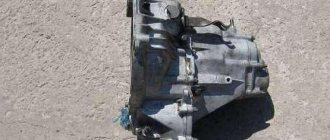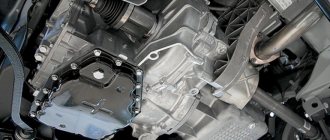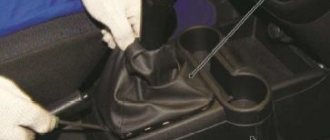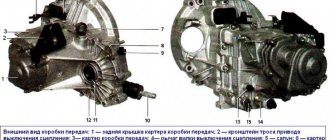Fuel consumption of Lada cars
AvtoVAZ cars are among the most popular in the domestic car market.
They are distinguished from foreign brands by their affordable price and moderate fuel consumption. Engineers and designers of the Tolyatti Automobile Plant have developed several generations of the Lada brand, providing buyers with a choice depending on visual and price preferences. But one of the main arguments when buying a car is its “gluttony” and, accordingly, the cost of filling a full tank. In practically all Lad models, fuel consumption per 100 km does not exceed 10 liters, but the exact data depends on many parameters. These include:
Today AvtoVAZ can offer potential buyers several Lada variants at once, having previously agreed on the material capabilities and technical needs of future car owners. Below we present the characteristics of the most popular models, and in the tables below them - the average fuel consumption of a Lada car per 100 km (A-95 gasoline is used as the basis, the unit of measurement is liter) when driving in the urban cycle, outside the city and in the mixed cycle. But the real performance of a particular car can only be established experimentally, having covered dozens of kilometers.
Advantages and disadvantages of automatic transmission
The Lada Granta/Kalina 2 is equipped with a Jatco automatic transmission; this gearbox has been installed on Nissan for more than two decades and has proven itself well during this time. Reviews from owners of Lada Granta with automatic transmission indicate that the automatic transmission shifts gears smoothly, on time and accurately. There is no excessive thoughtfulness, and sudden accelerations and braking do not confuse her.
The disadvantages of the machine include high fuel consumption, especially in urban areas, as well as very expensive repairs.
Fuel consumption Lada Kalina
The first Kalin prototypes appeared back in 1999, but serial production of these models began only in 2004. Initially, the car was produced in a sedan body, but later hatchbacks and station wagons were added to them. The cars were equipped with power units with volumes of 1.4 and 1.6 liters. The first made it possible to develop a power of 89 hp, the second - 81 hp. in the eight-valve version and 98 hp. in a sixteen-valve First generation cars have an exclusively manual transmission.
Since 2013, AvtoVAZ began production of the second generation Kalina, changing the appearance of the car and abandoning the sedan body (but a crossover modification appeared). The manufacturer also abandoned 1.4-liter engines, but the number of modifications with a 1.6-liter engine increased. In addition to mechanics, buyers were able to choose models with a four- or five-speed automatic transmission.
At the request of the buyer, Kalina is assembled with a 1.6-liter engine and a power of 136 hp.
| Engine | Consumption (city) | Consumption (highway) | Flow (mixed) | Type of fuel |
| 1.4 MT 89 hp (Mechanics) | 8.3 | 6.0 | 7.0 | Petrol |
| 1.6 MT 81 hp (Mechanics) | 9.8 | 6.1 | 7.8 | |
| 1.6 MT 90 hp (Mechanics) | 9.8 | 6.1 | 7.2 | |
| 1.6 MT 98 hp (Mechanics) | 9.4 | 5.8 | 7.2 | |
| 1.6 MT 98 hp (machine) | 9.9 | 6.1 | 7.6 | |
| 1.6 MT 106 hp (Mechanics) | 8.6 | 5.6 | 6.7 | |
| 1.6 AMT 106 hp (robot) | 8.6 | 5.6 | 6.7 |
We continue to compare AMT and automatic transmission
When choosing what is better for the Lada Kalina - an automatic or a robot, it is worth noting that the AMT version with five ranges has proven to be one of the most successful modifications. The robot functions more delicately than most Japanese or French counterparts. However, design features affect the noticeability of gear changes, which is most noticeable during active acceleration.
In comparison runs during test trials, it was clear that Kalina was a little faster than the model with an automatic transmission. True, this gap was only 0.2 tenths of a second, while acceleration with an automatic transmission was smoother and more pleasant to feel. The moment the gear is engaged on the Lada-Kalina, the automatic transmission is somewhat lubricated, which is due to the presence of oil operating in the transformer. AMT simply does not provide such a system.
New Lada: Disassembling and cleaning the central locking remote control (key) - Lada Kalina Blog
Fuel consumption Lada Granta
The Lada Granta model replaced the Kalina, which did not generate huge demand among consumers. In this modification, the creators of the car took into account the requirements of customers and developed several options for appearance and configuration. Since 2011, the model has been produced in a sedan body, and a little later a liftback version appeared on the market.
As a rule, Granta is equipped with a power unit of 1.6 liters in volume. The 8-valve version of the engine is capable of producing 87 hp, and is paired with either a five-speed manual transmission or a four-speed automatic. The 16-valve modification of the engine produces 106 hp. and is equipped with the same boxes.
The Lada Granta has a special “Sport” modification with a 116 hp engine. and with a manual five-speed gearbox.
| Engine | Consumption (city) | Consumption (highway) | Flow (mixed) | Type of fuel |
| 1.6 MT 82 hp (Mechanics) | 9.7 | 6.1 | 7.4 | Petrol |
| 1.6 MT 87 hp (Mechanics) | 9.0 | 5.8 | 7.0 | |
| 1.6 AT 87 hp (machine) | 10.4 | 6.1 | 7,7 | |
| 1.6 MT 98 hp (Mechanics) | 8.8 | 5.6 | 6.8 | |
| 1.6 AT 98 hp (machine) | 9.9 | 6.1 | 7.6 | |
| 1.6 MT 106 hp (Mechanics) | 8.6 | 5.6 | 6.7 | |
| 1.6 AMT 106 hp (robot) | 9.0 | 5.2 | 6.6 |
What's good about lada kalina and lada granta
Both models have an average ground clearance of 160 mm. This is enough to avoid getting caught in snow tracks in winter, but when parking near the curb you have to be careful: you can get caught in the overhang of the front bumper.
The suspension in both cases is energy-intensive, does not break through on bumps, but also does not allow excessive swaying during maneuvers. Both models handle simply, without any frills, but not in the same way as the “classic” car when cornering.
Spare parts for both cars are cheap and available in auto stores. A generator, for example, costs 4,000 rubles, and a complete set of improved silent blocks and bushings for the entire suspension will cost 3,500 rubles. The simple design of the cars allows repairs to be made at any service center without special unique tools.
The engines of both cars are quite economical. Fuel consumption for the engine is 87 l. With. and manual transmission - about 7 liters in mixed mode. Therefore, if the driver plans to travel frequently, but does not want to overpay for fuel, purchasing any of the AvtoVAZ models will be a practical option.
Car enthusiasts also characterize the automatic robotic gearbox as reliable and easy to maintain.
Both Lada Kalina and Lada Granta have a very warm stove in winter. AvtoVAZ’s many years of experience in producing cars for the Russian climate is telling.
But if you need a car for frequent transportation of goods, then the Kalina station wagon will be a more suitable choice. Its luggage compartment volume is 670 liters versus 520 liters for the Granta.
Lada Priora
When promoting the Lada Priora to the market, the manufacturer positioned it as a family car with a low cost. This model has been on sale since 2007. Priora has several body styles: sedan, station wagon, hatchback. The latter is produced in two modifications: with five doors and with three.
In 2013, the manufacturer made minor changes to the appearance of this Lada model and made the engines more powerful. The Priora is equipped with one of two petrol power units: either a 1.6 liter engine (the simplest has 8 valves and a power rating of 87 hp, and the most complex has 16 valves and 106 “horses”), or with a volume of 1.8 liters and with a capacity of 123 “horses”.
| Engine | Consumption (city) | Consumption (highway) | Flow (mixed) | Type of fuel |
| 1.6 MT 81 hp (Mechanics) | 9.8 | 5.6 | 7.6 | Petrol |
| 1.6 MT 98 hp (Mechanics) | 9.8 | 5.6 | 7.2 | |
| 1.6 MT 106 hp (Mechanics) | 8.9 | 5.6 | 6.8 | |
| 1.6 AMT 106 hp (robot) | 8.5 | 5.5 | 6.6 | |
| 1.8 MT 123 hp (Mechanics) | 9.8 | 5.6 | 7.2 |
Fuel consumption Lada Largus
The Lada Largus model is a joint development of the domestic AvtoVAZ and the French company Renault. After the official presentation in 2012, the cars went on sale in crossover, station wagon and van bodies. Depending on the model, the number of passenger seats and trunk cargo volume vary.
The base engine for all modifications is a 1.6-liter power unit. Its 8-valve version produces 87 horsepower, and the 16-valve version produces 102 horsepower. The engines are equipped with manual transmissions with five operating modes.
| Engine | Consumption (city) | Consumption (highway) | Flow (mixed) | Type of fuel |
| 1.6 MT 87 hp (Mechanics) | 10.6 | 6.7 | 8.2 | Petrol |
| 1.6 MT 102 hp (Mechanics) | 10.1 | 6.7 | 7.9 |
Design Features
First of all, the main design feature of the automatic transmission is its increased dimensions. The automatic transmission in Kalina takes up more space compared to a manual transmission, and this has a noticeable impact on the ground clearance. It decreased by 20 mm.
The second feature is the material from which the pallet is made. In this case, it is made of aluminum alloy, and this can be attributed, rather, to the disadvantages of the design.
Many people know that an aluminum pan can burst even from the slightest mechanical impact, and the engine will immediately be left without protection. Therefore, most experts recommend that when purchasing a Lada Kalina with an automatic transmission, replace the pan with a more durable version, for example, a steel one, as soon as possible.
Lada Xray
The first crossover to roll off the assembly lines of the Togliatti automobile plant was the Lada X-ray model. The presentation of the car took place at the Moscow Auto Show in 2012, and mass production of the new model began in 2015. The car is produced with 1.6-liter gasoline engines and a power of up to 110 hp. and equipped with a mechanical transmission.
In the near future, versions of the Lada Xray Cross with a 1.8 liter 16-valve power unit with a capacity of 122 hp should appear on sale. The Crosses are equipped with a five-speed manual transmission, but an automatic transmission can be installed at the client’s request. In addition, AvtoVAZ announced the release of X-ray “Sport” with engines of 16 valves and 1.8 liters in volume, developing a power of 145 “horses”.
Both new versions should feature qualitatively new suspensions.
| Engine | Consumption (city) | Consumption (highway) | Flow (mixed) | Type of fuel |
| 1.6 MT 106 hp (Mechanics) | 9.3 | 5.9 | 7.2 | Petrol |
| 1.6 MT 110 hp (Mechanics) | 8.9 | 5.6 | 6.8 | |
| 1.8 MT 122 hp (Mechanics) | 9.3 | 5.8 | 7.1 | |
| 1.8 AMT 122 hp (robot) | 8.6 | 5.8 | 6.8 |
Which model is more comfortable?
The interiors of both cars are spacious. The legs of the driver and passengers are positioned freely. But Kalina 2 uses high-quality plastic and modern seat materials. The Grants interior is made of low-quality materials that creak and wear out quickly.
The new Kalina seats have an orthopedic structure and are comfortable for people with bad backs and drivers who often have to travel long distances. The Granta seats are made without pronounced lateral support and are not very comfortable.
Leather interior and cruise control are not available in Russian cars in any of the trim levels. But Kalina 2 has climate control in the “luxury” version, as well as a heated windshield, a rain and light sensor. Granta does not have all these options.
Both cars have poor sound insulation. But the ride in Kalina 2 is still quieter.
So, in terms of the quality of interior materials and sound insulation, Kalina 2 outperforms Granta.
Fuel consumption Lada Vesta
Lada Vesta belongs to the new products of the domestic automobile industry. It was first presented in 2015, after which the model began to collect positive reviews and gain popularity at a rapid pace. Its advantages are its unusual appearance for domestic cars and excellent aerodynamics. Vesta also has high safety characteristics.
Now the car is produced exclusively in a sedan body, but in the near future the Togliatti car plant plans to produce Vesta in station wagon and liftback modifications. The car is equipped with engines of 106 “horses” and a volume of 1.6 liters, equipped with a manual or automatic transmission. The version of the 1.8-liter engine has more power indicators - 122 hp. and automatic transmission.
| Engine | Consumption (city) | Consumption (highway) | Flow (mixed) | Type of fuel |
| 1.6 MT 106 hp (Mechanics) | 9.3 | 5.5 | 6.9 | Petrol |
| 1.6 AMT 106 hp (robot) | 9.0 | 5.3 | 6.6 | |
| 1.8 AMT 122 hp (robot) | 9.3 | 6.0 | 7.2 |
Manufacturers of Lada cars are trying to keep up with the times and are making a lot of efforts to reduce the fuel consumption of their products and make their operating costs affordable for ordinary motorists.
Source
What's wrong with lada kalina and lada granta
No matter how hard the domestic tried, it didn’t happen. Both cars have their drawbacks, which apply equally to both models.
The quality of the interior trim leaves much to be desired. The plastic creaks and scratches easily. But the updated Kalina 2 received a number of improvements, based on the experience of Grants. There are fewer creaks in the cabin, and the sound insulation is better.
The lack of anti-corrosion treatment of the metal is also not long in coming. Rust appears in places where stones and gravel are chipped if these areas are not touched up.
Separately, in Kalina 1, drivers noted the uncomfortable front seats. Due to the lack of lumbar support, drivers' backs became tired on long trips. This problem has been fixed in the updated second version. And although the design of the suspension and steering of the cars is almost the same, the steering rack of the Kalina 2 often breaks.
It is necessary to dwell separately on the Grants generator, since it fails on almost all cars produced in the first half of 2021. Owners complain that the breakdown is detected after 3-5 thousand kilometers, and dealer service stations refuse to fix it, citing a lack of spare parts.
How much gasoline does Lada Kalina consume - passport and real data
In November 2004, the first series of the Lada Kalina people's car came off the assembly line of the AvtoVAZ concern. According to some reports, the first samples of small-scale production appeared on the market back in 1998. When production was established, the car began to be equipped in three body types: a 5-door hatchback and a sedan, and later a station wagon. The manufacturer's data indicates that the fuel consumption of the Lada Kalina is at an average level, which is confirmed by numerous reviews from owners. Subsequently, both the body and the power unit of this car were modernized, and today the second series of LADA Kalina is being produced.
Advantages and disadvantages of automatic transmission
The Lada Granta/Kalina 2 is equipped with a Jatco automatic transmission; this gearbox has been installed on Nissan for more than two decades and has proven itself well during this time. Reviews from owners of Lada Granta with automatic transmission indicate that the automatic transmission shifts gears smoothly, on time and accurately. There is no excessive thoughtfulness, and sudden accelerations and braking do not confuse her.
The disadvantages of the machine include high fuel consumption, especially in urban areas, as well as very expensive repairs.
Official data on gasoline consumption
There are two series of cars and several more of their modifications; data on gasoline consumption of the Lada Kalina differ somewhat, depending on the installed engine and body type. Typically, a station wagon consumes more gas than a hatchback or sedan due to the vehicle's greater weight. However, according to the manufacturer, there may be a slight difference in consumption even between a hatchback and a sedan of the same series, modification and year of manufacture.
In theory, the Lada Kalina has an average gasoline consumption for a 1.4 liter engine of about 9.6 liters. in the city and up to 6.3 l. when driving on an open road. Naturally, each modification has its own characteristics, parameters and technical characteristics; we will consider below exactly how this affects the fuel consumption of the Lada Kalina.
How does the automatic transmission behave?
Many users note in their reviews that it makes no sense to get used to an outdated, albeit automatic, modification of the gearbox if it does not differ much in its operation from the AMT. But the Jatko box has a lot of advantages. Firstly, it shifts smoother, although slower than a modern AMT.
New Lada: Topic: Turn signal fuse blows. Where is the source of the problems?
The main problem with the Jatco automatic transmission is fuel consumption. In the city in the off-season, taking into account traffic jams, slipping, and frequent stops, the automatic transmission will “eat up” from 11.5 to 12.5 liters per hundred kilometers, depending on driving style. Under similar conditions, a car with AMT consumes about 8.5 l/100 km.
First generation
The first sedan car went on sale in 2004; the car was equipped with a 1.4 liter engine with 89 horsepower. Fuel consumption of Lada Kalina 1118 (factory designation) had the following values:
It should be noted that in 2009 the production of the first generation of LADA Kalina sedans was suspended, but within a few months the cycle was established, and until 2011 this model was produced by the AvtoVAZ concern.
Hatchbacks went on sale a little later, towards the end of 2006, and then production of the Lada Kalina (1119) was launched. These cars, as well as sedans, began to be equipped with a more powerful engine, which had a 1.6 liter fuel compartment and was produced with a power of 81 hp and 98 hp. According to the requests of the factory developers, which corresponded to the reviews of the owners, the car with an 81-horsepower engine had the following fuel consumption indicators per hundred kilometers:
As for the 98 horsepower engine, the consumption per hundred kilometers of road under different conditions is:
Only in 2007, the automobile concern rolled out the Lada Kalina with a station wagon (1117), its fuel consumption parameters are approximately the same as those of cars in other bodies, except that when driving in the city it consumes 200-300 grams. more gasoline.
One of the branches produced in limited series was the LADA Kalina Sport (11196), this car was released in 2008. Her gasoline consumption figures per 100 km are:
Like the entire first series, LADA Kalina Sport ceased production in mid-2013.
Real data, according to owner reviews
Advantages and disadvantages of automatic transmission
The Lada Granta/Kalina 2 is equipped with a Jatco automatic transmission; this gearbox has been installed on Nissan for more than two decades and has proven itself well during this time. Reviews from owners of Lada Granta with automatic transmission indicate that the automatic transmission shifts gears smoothly, on time and accurately. There is no excessive thoughtfulness, and sudden accelerations and braking do not confuse her.
The disadvantages of the machine include high fuel consumption, especially in urban areas, as well as very expensive repairs.
Second generation
Since 2013, the Lada Kalina car line has been updated and new cars have entered the market. Among them was not the usual sedan, with which the series began production, but the production of 5-door hatchbacks and station wagons continued. Fuel consumption on the new Lada Kalina has been reduced, but the manufacturer's requests do not always correspond to customer reviews.
The second Kalina came with two types of engines, each with a volume of 1.6 liters, but their power differed. There was also a choice of transmission options; as before, it was possible to purchase a car with a manual 5-speed gearbox or with a 4-speed automatic. A new feature was the entry into the arena of a 5-speed robotic transmission.
The power units installed on the Lada Kalina 2 had the following fuel consumption:
Owners about consumption on Kalina 2
Owner reviews
Owners of Lada Kalina, which has an automatic transmission, often complain about a number of problems that most often appear on this model.
The first thing that worries you during operation is the gearbox. The shift itself occurs without problems, the lever firmly falls into place when you engage any of the positions, but in order to place the lever between gears, you need to sweat. For some reason, these positions are not very noticeable when shifting, and you can easily skip them, and the car will be in gear again.
The second thing I would like to note is the close location of the gas and brake pedals. When you press the gas, you can involuntarily engage the second pedal. Of course, not so much that the brake will work, but still, you will feel it.
Further, owners of Lada cars often have the following problem: when driving, the “Check Engine” light may come on. What’s remarkable is that the car behaves as if nothing had happened. Experts recommend solving the problem by removing the terminal for 5 minutes. This is explained by the fact that this inscription is a common system error. If removing the terminal does not help you, do not rush to get upset. There are times when the light bulb goes out on its own.











